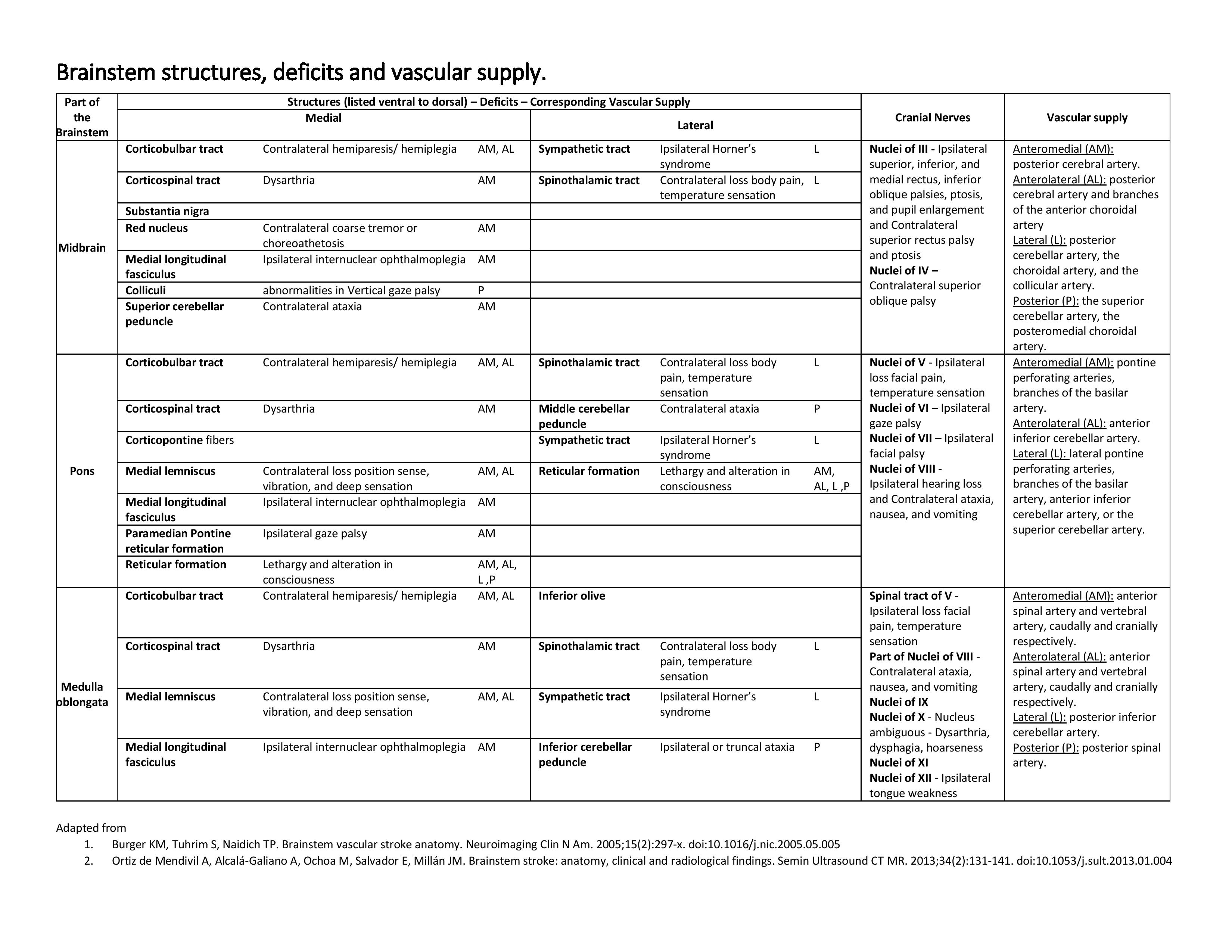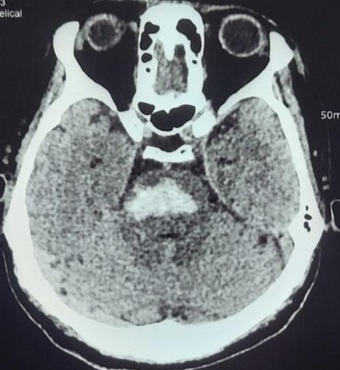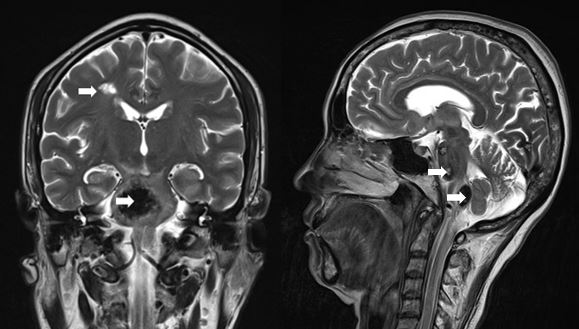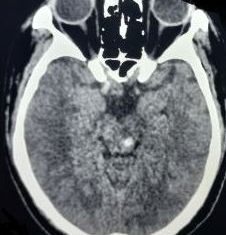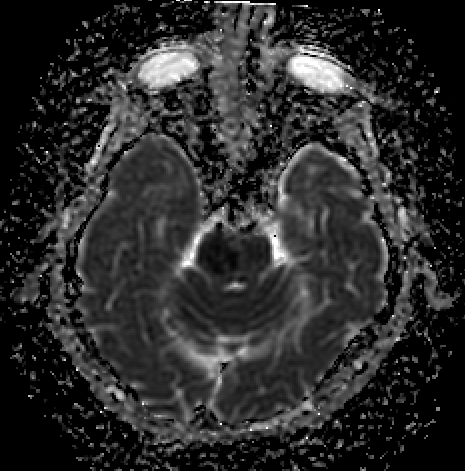[1]
AlMohammedi RM, AlMutairi H, AlHoussien RO, AlOtayan MT, AlMutairi AK, Bafail WO, Khan A, Khatri IA. Brainstem hemorrhage is uncommon and is associated with high morbidity, mortality, and prolonged hospitalization. Neurosciences (Riyadh, Saudi Arabia). 2020 Apr:25(2):91-96. doi: 10.17712/nsj.2020.2.20190102. Epub
[PubMed PMID: 32351245]
[2]
Angeles Fernández-Gil M, Palacios-Bote R, Leo-Barahona M, Mora-Encinas JP. Anatomy of the brainstem: a gaze into the stem of life. Seminars in ultrasound, CT, and MR. 2010 Jun:31(3):196-219. doi: 10.1053/j.sult.2010.03.006. Epub
[PubMed PMID: 20483389]
[3]
Ortiz de Mendivil A, Alcalá-Galiano A, Ochoa M, Salvador E, Millán JM. Brainstem stroke: anatomy, clinical and radiological findings. Seminars in ultrasound, CT, and MR. 2013 Apr:34(2):131-41. doi: 10.1053/j.sult.2013.01.004. Epub
[PubMed PMID: 23522778]
[4]
Nogueira RG, Jadhav AP, Haussen DC, Bonafe A, Budzik RF, Bhuva P, Yavagal DR, Ribo M, Cognard C, Hanel RA, Sila CA, Hassan AE, Millan M, Levy EI, Mitchell P, Chen M, English JD, Shah QA, Silver FL, Pereira VM, Mehta BP, Baxter BW, Abraham MG, Cardona P, Veznedaroglu E, Hellinger FR, Feng L, Kirmani JF, Lopes DK, Jankowitz BT, Frankel MR, Costalat V, Vora NA, Yoo AJ, Malik AM, Furlan AJ, Rubiera M, Aghaebrahim A, Olivot JM, Tekle WG, Shields R, Graves T, Lewis RJ, Smith WS, Liebeskind DS, Saver JL, Jovin TG, DAWN Trial Investigators. Thrombectomy 6 to 24 Hours after Stroke with a Mismatch between Deficit and Infarct. The New England journal of medicine. 2018 Jan 4:378(1):11-21. doi: 10.1056/NEJMoa1706442. Epub 2017 Nov 11
[PubMed PMID: 29129157]
[5]
Kameda W, Kawanami T, Kurita K, Daimon M, Kayama T, Hosoya T, Kato T, Study Group of the Association of Cerebrovascular Disease in Tohoku. Lateral and medial medullary infarction: a comparative analysis of 214 patients. Stroke. 2004 Mar:35(3):694-9
[PubMed PMID: 14963274]
Level 2 (mid-level) evidence
[6]
Burger KM, Tuhrim S, Naidich TP. Brainstem vascular stroke anatomy. Neuroimaging clinics of North America. 2005 May:15(2):297-324, x
[PubMed PMID: 16198942]
[7]
Baran G, Gultekin TO, Baran O, Deniz C, Katar S, Yildiz GB, Asil T. Association between etiology and lesion site in ischemic brainstem infarcts: a retrospective observational study. Neuropsychiatric disease and treatment. 2018:14():757-766. doi: 10.2147/NDT.S154224. Epub 2018 Mar 13
[PubMed PMID: 29559783]
Level 2 (mid-level) evidence
[8]
Bogousslavsky J, Van Melle G, Regli F. The Lausanne Stroke Registry: analysis of 1,000 consecutive patients with first stroke. Stroke. 1988 Sep:19(9):1083-92
[PubMed PMID: 3413804]
[9]
Guzik A, Bushnell C. Stroke Epidemiology and Risk Factor Management. Continuum (Minneapolis, Minn.). 2017 Feb:23(1, Cerebrovascular Disease):15-39. doi: 10.1212/CON.0000000000000416. Epub
[PubMed PMID: 28157742]
[10]
Munakomi S, Torregrossa F, Grasso G. Natural Course, Clinical Profile, and Treatment Strategies for Cerebral Cavernous Malformations. World neurosurgery. 2022 Mar:159():373-380. doi: 10.1016/j.wneu.2021.08.134. Epub
[PubMed PMID: 35255636]
[11]
Kaji R. Global burden of neurological diseases highlights stroke. Nature reviews. Neurology. 2019 Jul:15(7):371-372. doi: 10.1038/s41582-019-0208-y. Epub
[PubMed PMID: 31152152]
[12]
Virani SS, Alonso A, Benjamin EJ, Bittencourt MS, Callaway CW, Carson AP, Chamberlain AM, Chang AR, Cheng S, Delling FN, Djousse L, Elkind MSV, Ferguson JF, Fornage M, Khan SS, Kissela BM, Knutson KL, Kwan TW, Lackland DT, Lewis TT, Lichtman JH, Longenecker CT, Loop MS, Lutsey PL, Martin SS, Matsushita K, Moran AE, Mussolino ME, Perak AM, Rosamond WD, Roth GA, Sampson UKA, Satou GM, Schroeder EB, Shah SH, Shay CM, Spartano NL, Stokes A, Tirschwell DL, VanWagner LB, Tsao CW, American Heart Association Council on Epidemiology and Prevention Statistics Committee and Stroke Statistics Subcommittee. Heart Disease and Stroke Statistics-2020 Update: A Report From the American Heart Association. Circulation. 2020 Mar 3:141(9):e139-e596. doi: 10.1161/CIR.0000000000000757. Epub 2020 Jan 29
[PubMed PMID: 31992061]
[13]
GBD 2016 Causes of Death Collaborators. Global, regional, and national age-sex specific mortality for 264 causes of death, 1980-2016: a systematic analysis for the Global Burden of Disease Study 2016. Lancet (London, England). 2017 Sep 16:390(10100):1151-1210. doi: 10.1016/S0140-6736(17)32152-9. Epub
[PubMed PMID: 28919116]
Level 1 (high-level) evidence
[14]
Teasell R, Foley N, Doherty T, Finestone H. Clinical characteristics of patients with brainstem strokes admitted to a rehabilitation unit. Archives of physical medicine and rehabilitation. 2002 Jul:83(7):1013-6
[PubMed PMID: 12098164]
[15]
Chen P, Yao H, Tang X, Wang Y, Zhang Q, Liu Y, Hu J, Deng Y. Management of Primary Brainstem Hemorrhage: A Review of Outcome Prediction, Surgical Treatment, and Animal Model. Disease markers. 2022:2022():4293590. doi: 10.1155/2022/4293590. Epub 2022 Jul 12
[PubMed PMID: 35864996]
Level 3 (low-level) evidence
[16]
Markus HS. Cerebral perfusion and stroke. Journal of neurology, neurosurgery, and psychiatry. 2004 Mar:75(3):353-61
[PubMed PMID: 14966145]
[17]
Mergenthaler P, Lindauer U, Dienel GA, Meisel A. Sugar for the brain: the role of glucose in physiological and pathological brain function. Trends in neurosciences. 2013 Oct:36(10):587-97. doi: 10.1016/j.tins.2013.07.001. Epub 2013 Aug 20
[PubMed PMID: 23968694]
[18]
Deb P, Sharma S, Hassan KM. Pathophysiologic mechanisms of acute ischemic stroke: An overview with emphasis on therapeutic significance beyond thrombolysis. Pathophysiology : the official journal of the International Society for Pathophysiology. 2010 Jun:17(3):197-218. doi: 10.1016/j.pathophys.2009.12.001. Epub 2010 Jan 13
[PubMed PMID: 20074922]
Level 3 (low-level) evidence
[19]
Klatzo I. Presidental address. Neuropathological aspects of brain edema. Journal of neuropathology and experimental neurology. 1967 Jan:26(1):1-14
[PubMed PMID: 5336776]
[20]
Adibhatla RM, Hatcher JF. Altered lipid metabolism in brain injury and disorders. Sub-cellular biochemistry. 2008:49():241-68. doi: 10.1007/978-1-4020-8831-5_9. Epub
[PubMed PMID: 18751914]
[21]
Guo X, Ma L, Li H, Qi X, Wei Y, Duan Z, Xu J, Wang C, You C, Tian M. Brainstem iron overload and injury in a rat model of brainstem hemorrhage. Journal of stroke and cerebrovascular diseases : the official journal of National Stroke Association. 2020 Aug:29(8):104956. doi: 10.1016/j.jstrokecerebrovasdis.2020.104956. Epub 2020 Jun 5
[PubMed PMID: 32689646]
Level 2 (mid-level) evidence
[23]
Querol-Pascual MR. Clinical approach to brainstem lesions. Seminars in ultrasound, CT, and MR. 2010 Jun:31(3):220-9. doi: 10.1053/j.sult.2010.03.004. Epub
[PubMed PMID: 20483390]
[24]
Gates P. The rule of 4 of the brainstem: a simplified method for understanding brainstem anatomy and brainstem vascular syndromes for the non-neurologist. Internal medicine journal. 2005 Apr:35(4):263-6
[PubMed PMID: 15836511]
Level 3 (low-level) evidence
[25]
Srinivasan A, Goyal M, Al Azri F, Lum C. State-of-the-art imaging of acute stroke. Radiographics : a review publication of the Radiological Society of North America, Inc. 2006 Oct:26 Suppl 1():S75-95
[PubMed PMID: 17050521]
[26]
Balami JS, Chen RL, Buchan AM. Stroke syndromes and clinical management. QJM : monthly journal of the Association of Physicians. 2013 Jul:106(7):607-15. doi: 10.1093/qjmed/hct057. Epub 2013 Mar 12
[PubMed PMID: 23483140]
[27]
Wall M, Wray SH. The one-and-a-half syndrome--a unilateral disorder of the pontine tegmentum: a study of 20 cases and review of the literature. Neurology. 1983 Aug:33(8):971-80
[PubMed PMID: 6683820]
Level 3 (low-level) evidence
[28]
Sciacca S, Lynch J, Davagnanam I, Barker R. Midbrain, Pons, and Medulla: Anatomy and Syndromes. Radiographics : a review publication of the Radiological Society of North America, Inc. 2019 Jul-Aug:39(4):1110-1125. doi: 10.1148/rg.2019180126. Epub
[PubMed PMID: 31283463]
[29]
Liu GT, Crenner CW, Logigian EL, Charness ME, Samuels MA. Midbrain syndromes of Benedikt, Claude, and Nothnagel: setting the record straight. Neurology. 1992 Sep:42(9):1820-2
[PubMed PMID: 1513475]
[30]
Cormier PJ, Long ER, Russell EJ. MR imaging of posterior fossa infarctions: vascular territories and clinical correlates. Radiographics : a review publication of the Radiological Society of North America, Inc. 1992 Nov:12(6):1079-96
[PubMed PMID: 1439013]
[31]
Marx JJ, Thömke F. Classical crossed brain stem syndromes: myth or reality? Journal of neurology. 2009 Jun:256(6):898-903. doi: 10.1007/s00415-009-5037-2. Epub 2009 Feb 28
[PubMed PMID: 19252797]
[32]
Moncayo J. Midbrain infarcts and hemorrhages. Frontiers of neurology and neuroscience. 2012:30():158-61. doi: 10.1159/000333630. Epub 2012 Feb 14
[PubMed PMID: 22377886]
[33]
Tacik P, Krasnianski M, Alfieri A, Dressler D. Brissaud-Sicard syndrome caused by a diffuse brainstem glioma. A rare differential diagnosis of hemifacial spasm. Acta neurochirurgica. 2014 Feb:156(2):429-30. doi: 10.1007/s00701-013-1984-6. Epub 2014 Jan 3
[PubMed PMID: 24384991]
[34]
Krasnianski M, Neudecker S, Zierz S. [Classical crossed pontine syndromes]. Fortschritte der Neurologie-Psychiatrie. 2004 Aug:72(8):460-8
[PubMed PMID: 15305240]
[35]
Stalcup ST, Tuan AS, Hesselink JR. Intracranial causes of ophthalmoplegia: the visual reflex pathways. Radiographics : a review publication of the Radiological Society of North America, Inc. 2013 Sep-Oct:33(5):E153-69. doi: 10.1148/rg.335125142. Epub
[PubMed PMID: 24025940]
[36]
Tacik P, Alfieri A, Kornhuber M, Dressler D. Gasperini's syndrome: its neuroanatomical basis now and then. Journal of the history of the neurosciences. 2012 Jan:21(1):17-30. doi: 10.1080/0964704X.2011.568045. Epub
[PubMed PMID: 22239093]
[37]
Hubloue I, Laureys S, Michotte A. A rare case of diplopia: medial inferior pontine syndrome or Foville's syndrome. European journal of emergency medicine : official journal of the European Society for Emergency Medicine. 1996 Sep:3(3):194-8
[PubMed PMID: 9023501]
Level 3 (low-level) evidence
[38]
Zaorsky NG, Luo JJ. A case of classic raymond syndrome. Case reports in neurological medicine. 2012:2012():583123. doi: 10.1155/2012/583123. Epub 2012 Aug 9
[PubMed PMID: 22934209]
[39]
Krasnianski M, Neudecker S, Schlüter A, Zierz S. [Avellis' syndrome in brainstem infarctions]. Fortschritte der Neurologie-Psychiatrie. 2003 Dec:71(12):650-3
[PubMed PMID: 14661158]
[40]
Krasnianski M, Müller T, Stock K, Zierz S. Between Wallenberg syndrome and hemimedullary lesion: Cestan-Chenais and Babinski-Nageotte syndromes in medullary infarctions. Journal of neurology. 2006 Nov:253(11):1442-6
[PubMed PMID: 16775654]
[42]
Krasnianski M, Winterholler M, Neudecker S, Zierz S. [Classical crossed syndromes of the medulla oblongata. A historical and topodiagnostic discussion]. Fortschritte der Neurologie-Psychiatrie. 2003 Aug:71(8):397-405
[PubMed PMID: 12910445]
[43]
Pergami P, Poloni TE, Imbesi F, Ceroni M, Simonetti F. Dejerine's syndrome or Spiller's syndrome? Neurological sciences : official journal of the Italian Neurological Society and of the Italian Society of Clinical Neurophysiology. 2001 Aug:22(4):333-6
[PubMed PMID: 11808859]
[44]
Saposnik G, Caplan LR. Convulsive-like movements in brainstem stroke. Archives of neurology. 2001 Apr:58(4):654-7
[PubMed PMID: 11295998]
[45]
Kalampokini S, Poyiadjis S, Vavougios GD, Artemiadis A, Zis P, Hadjigeorgiou GM, Bargiotas P. Restless legs syndrome due to brainstem stroke: A systematic review. Acta neurologica Scandinavica. 2022 Nov:146(5):440-447. doi: 10.1111/ane.13702. Epub 2022 Sep 5
[PubMed PMID: 36063288]
Level 1 (high-level) evidence
[46]
Chen D, Tang Y, Nie H, Zhang P, Wang W, Dong Q, Wu G, Xue M, Tang Y, Liu W, Pan C, Tang Z. Primary Brainstem Hemorrhage: A Review of Prognostic Factors and Surgical Management. Frontiers in neurology. 2021:12():727962. doi: 10.3389/fneur.2021.727962. Epub 2021 Sep 10
[PubMed PMID: 34566872]
[47]
Kothari RU, Brott T, Broderick JP, Barsan WG, Sauerbeck LR, Zuccarello M, Khoury J. The ABCs of measuring intracerebral hemorrhage volumes. Stroke. 1996 Aug:27(8):1304-5
[PubMed PMID: 8711791]
[48]
Musuka TD, Wilton SB, Traboulsi M, Hill MD. Diagnosis and management of acute ischemic stroke: speed is critical. CMAJ : Canadian Medical Association journal = journal de l'Association medicale canadienne. 2015 Sep 8:187(12):887-93. doi: 10.1503/cmaj.140355. Epub 2015 Aug 4
[PubMed PMID: 26243819]
[49]
Hacke W, Kaste M, Bluhmki E, Brozman M, Dávalos A, Guidetti D, Larrue V, Lees KR, Medeghri Z, Machnig T, Schneider D, von Kummer R, Wahlgren N, Toni D, ECASS Investigators. Thrombolysis with alteplase 3 to 4.5 hours after acute ischemic stroke. The New England journal of medicine. 2008 Sep 25:359(13):1317-29. doi: 10.1056/NEJMoa0804656. Epub
[PubMed PMID: 18815396]
[50]
Re-examining Acute Eligibility for Thrombolysis (TREAT) Task Force:, Levine SR, Khatri P, Broderick JP, Grotta JC, Kasner SE, Kim D, Meyer BC, Panagos P, Romano J, Scott P, NINDS rt-PA Stroke Trial Investigators. Review, historical context, and clarifications of the NINDS rt-PA stroke trials exclusion criteria: Part 1: rapidly improving stroke symptoms. Stroke. 2013 Sep:44(9):2500-5. doi: 10.1161/STROKEAHA.113.000878. Epub 2013 Jul 11
[PubMed PMID: 23847249]
[51]
Powers WJ, Rabinstein AA, Ackerson T, Adeoye OM, Bambakidis NC, Becker K, Biller J, Brown M, Demaerschalk BM, Hoh B, Jauch EC, Kidwell CS, Leslie-Mazwi TM, Ovbiagele B, Scott PA, Sheth KN, Southerland AM, Summers DV, Tirschwell DL. Guidelines for the Early Management of Patients With Acute Ischemic Stroke: 2019 Update to the 2018 Guidelines for the Early Management of Acute Ischemic Stroke: A Guideline for Healthcare Professionals From the American Heart Association/American Stroke Association. Stroke. 2019 Dec:50(12):e344-e418. doi: 10.1161/STR.0000000000000211. Epub 2019 Oct 30
[PubMed PMID: 31662037]
[52]
Sigurdsson AP, Gunnarsson T, Thorisson HM, Olafsson IH, Gunnarsson GB. [Occlusion of the vertebrobasilar artery. Case presentation and literature review]. Laeknabladid. 2020 Jun:106(6):302-309. doi: 10.17992/lbl.2020.06.586. Epub
[PubMed PMID: 32491992]
[53]
Diprose WK, Diprose JP, Tarr GP, Sutcliffe J, McFetridge A, Brew S, Caldwell J, McGuinness B, Wang MTM, Barber PA. Vertebrobasilar Artery Calcification and Outcomes in Posterior Circulation Large Vessel Occlusion Thrombectomy. Stroke. 2020 Apr:51(4):1301-1304. doi: 10.1161/STROKEAHA.119.027958. Epub 2020 Feb 14
[PubMed PMID: 32078499]
[54]
Kang DH, Jung C, Yoon W, Kim SK, Baek BH, Kim JT, Park MS, Kim YW, Hwang YH, Kim YS, Kim BJ, Han MK, Bae HJ. Endovascular Thrombectomy for Acute Basilar Artery Occlusion: A Multicenter Retrospective Observational Study. Journal of the American Heart Association. 2018 Jul 7:7(14):. doi: 10.1161/JAHA.118.009419. Epub 2018 Jul 7
[PubMed PMID: 29982231]
Level 2 (mid-level) evidence
[55]
Fan Y, Li Y, Zhang T, Li X, Yang J, Wang B, Jiang C. Endovascular therapy for acute vertebrobasilar occlusion underlying atherosclerosis: A single institution experience. Clinical neurology and neurosurgery. 2019 Jan:176():78-82. doi: 10.1016/j.clineuro.2018.11.016. Epub 2018 Nov 29
[PubMed PMID: 30544008]
[56]
Boeckh-Behrens T, Pree D, Lummel N, Friedrich B, Maegerlein C, Kreiser K, Kirschke J, Berndt M, Lehm M, Wunderlich S, Mosimann PJ, Fischer U, Zimmer C, Kaesmacher J. Vertebral Artery Patency and Thrombectomy in Basilar Artery Occlusions. Stroke. 2019 Feb:50(2):389-395. doi: 10.1161/STROKEAHA.118.022466. Epub
[PubMed PMID: 30612534]
Level 3 (low-level) evidence
[57]
Sang HF, Yin CG, Xia WQ, Huang H, Liu KQ, Chen TW, Si XL, Jiang L. Mechanical Thrombectomy Using Solitaire in Acute Ischemic Stroke Patients with Vertebrobasilar Occlusion: A Prospective Observational Study. World neurosurgery. 2019 Aug:128():e355-e361. doi: 10.1016/j.wneu.2019.04.152. Epub 2019 Apr 25
[PubMed PMID: 31029819]
Level 2 (mid-level) evidence
[58]
Quan T, Hou H, Xue W, Yu G, Ma H, Sun J, Guan S, Xu Y, Xu H. Endovascular treatment of acute intracranial vertebrobasilar artery occlusion: a multicenter retrospective observational study. Neuroradiology. 2019 Dec:61(12):1477-1484. doi: 10.1007/s00234-019-02282-1. Epub 2019 Sep 4
[PubMed PMID: 31482191]
Level 2 (mid-level) evidence
[59]
Uno J, Kameda K, Otsuji R, Ren N, Nagaoka S, Maeda K, Ikai Y, Gi H. Mechanical Thrombectomy for Basilar Artery Occlusion Compared with Anterior Circulation Stroke. World neurosurgery. 2020 Feb:134():e469-e475. doi: 10.1016/j.wneu.2019.10.097. Epub 2019 Oct 24
[PubMed PMID: 31669246]
[60]
Liu X, Dai Q, Ye R, Zi W, Liu Y, Wang H, Zhu W, Ma M, Yin Q, Li M, Fan X, Sun W, Han Y, Lv Q, Liu R, Yang D, Shi Z, Zheng D, Deng X, Wan Y, Wang Z, Geng Y, Chen X, Zhou Z, Liao G, Jin P, Liu Y, Liu X, Zhang M, Zhou F, Shi H, Zhang Y, Guo F, Yin C, Niu G, Zhang M, Cai X, Zhu Q, Chen Z, Liang Y, Li B, Lin M, Wang W, Xu H, Fu X, Liu W, Tian X, Gong Z, Shi H, Wang C, Lv P, Tao Z, Zhu L, Yang S, Hu W, Jiang P, Liebeskind DS, Pereira VM, Leung T, Yan B, Davis S, Xu G, Nogueira RG, BEST Trial Investigators. Endovascular treatment versus standard medical treatment for vertebrobasilar artery occlusion (BEST): an open-label, randomised controlled trial. The Lancet. Neurology. 2020 Feb:19(2):115-122. doi: 10.1016/S1474-4422(19)30395-3. Epub 2019 Dec 9
[PubMed PMID: 31831388]
[61]
Baek JH, Kim BM, Heo JH, Kim DJ, Nam HS, Kim YD. Endovascular and Clinical Outcomes of Vertebrobasilar Intracranial Atherosclerosis-Related Large Vessel Occlusion. Frontiers in neurology. 2019:10():215. doi: 10.3389/fneur.2019.00215. Epub 2019 Mar 19
[PubMed PMID: 30941084]
Level 2 (mid-level) evidence
[62]
Cavalcanti DD, Preul MC, Kalani MY, Spetzler RF. Microsurgical anatomy of safe entry zones to the brainstem. Journal of neurosurgery. 2016 May:124(5):1359-76. doi: 10.3171/2015.4.JNS141945. Epub 2015 Oct 9
[PubMed PMID: 26452114]
[63]
Yang Y, van Niftrik B, Ma X, Velz J, Wang S, Regli L, Bozinov O. Analysis of safe entry zones into the brainstem. Neurosurgical review. 2019 Sep:42(3):721-729. doi: 10.1007/s10143-019-01081-9. Epub 2019 Feb 6
[PubMed PMID: 30726522]
[64]
Summers D, Leonard A, Wentworth D, Saver JL, Simpson J, Spilker JA, Hock N, Miller E, Mitchell PH, American Heart Association Council on Cardiovascular Nursing and the Stroke Council. Comprehensive overview of nursing and interdisciplinary care of the acute ischemic stroke patient: a scientific statement from the American Heart Association. Stroke. 2009 Aug:40(8):2911-44. doi: 10.1161/STROKEAHA.109.192362. Epub 2009 May 28
[PubMed PMID: 19478222]
Level 3 (low-level) evidence
[65]
Farhoudi M, Sadigh-Eteghad S, Farjami A, Salatin S. Nanoparticle and Stem Cell Combination Therapy for the Management of Stroke. Current pharmaceutical design. 2023:29(1):15-29. doi: 10.2174/1381612829666221213113119. Epub
[PubMed PMID: 36515043]
[66]
Mohd Satar A, Othman FA, Tan SC. Biomaterial application strategies to enhance stem cell-based therapy for ischemic stroke. World journal of stem cells. 2022 Dec 26:14(12):851-867. doi: 10.4252/wjsc.v14.i12.851. Epub
[PubMed PMID: 36619694]
[67]
Schonewille WJ, Algra A, Serena J, Molina CA, Kappelle LJ. Outcome in patients with basilar artery occlusion treated conventionally. Journal of neurology, neurosurgery, and psychiatry. 2005 Sep:76(9):1238-41
[PubMed PMID: 16107358]
[68]
Sheng K, Tong M. Therapy for acute basilar artery occlusion: a systematic review and meta-analysis. F1000Research. 2019:8():165. doi: 10.12688/f1000research.18042.1. Epub 2019 Feb 7
[PubMed PMID: 31016013]
Level 1 (high-level) evidence
[69]
Dorňák T, Král M, Šaňák D, Kaňovský P. Intravenous Thrombolysis in Posterior Circulation Stroke. Frontiers in neurology. 2019:10():417. doi: 10.3389/fneur.2019.00417. Epub 2019 Apr 26
[PubMed PMID: 31080436]
[70]
Malik A, Drumm B, D'Anna L, Brooks I, Low B, Raha O, Shabbir K, Vittay O, Kwan J, Brown Z, Halse O, Jamil S, Kalladka D, Venter M, Jenkins H, Rane N, Singh A, Patel M, Hall C, Fatania G, Roi D, Lobotesis K, Banerjee S. Mechanical thrombectomy in acute basilar artery stroke: a systematic review and Meta-analysis of randomized controlled trials. BMC neurology. 2022 Nov 9:22(1):415. doi: 10.1186/s12883-022-02953-2. Epub 2022 Nov 9
[PubMed PMID: 36352362]
Level 1 (high-level) evidence
[71]
Nso N, Nassar M, Trimingham M, Mbome Y, Lyonga Ngonge A, Badejoko SO, Akbar S, Azhar A, Lakhdar S, Ghallab M, Guzman Perez LM, Rizzo V, Munira MS. Invasive Management of Vertebrobasilar Artery Stenosis and Occlusion: A Meta-Analysis on Efficacy and Safety Endpoints. Cureus. 2022 May:14(5):e24751. doi: 10.7759/cureus.24751. Epub 2022 May 5
[PubMed PMID: 35686282]
Level 1 (high-level) evidence
[72]
Zhao FL, Mi DH, Zhang CQ, Song QH, Liu HS, Dai HL, Liu ZM, Ge CQ, Wang YJ, Liu LP, Guo L. A cohort study of isolated brainstem infarction based on head MR imaging and clinical findings. The Journal of international medical research. 2018 Dec:46(12):4974-4984. doi: 10.1177/0300060518788253. Epub 2018 Sep 23
[PubMed PMID: 30246581]
[73]
Zheng WJ, Shi SW, Gong J. The truths behind the statistics of surgical treatment for hypertensive brainstem hemorrhage in China: a review. Neurosurgical review. 2022 Apr:45(2):1195-1204. doi: 10.1007/s10143-021-01683-2. Epub 2021 Oct 29
[PubMed PMID: 34716511]
[74]
Behrouz R. Prognostic factors in pontine haemorrhage: A systematic review. European stroke journal. 2018 Jun:3(2):101-109. doi: 10.1177/2396987317752729. Epub 2018 Jan 8
[PubMed PMID: 31008342]
Level 1 (high-level) evidence
[75]
Meng X, Wang Q, Pei X, Xie F. Prognosis and Influencing Factors of Early Microsurgery for Severe Hypertensive Brainstem Hemorrhage. Disease markers. 2022:2022():5062591. doi: 10.1155/2022/5062591. Epub 2022 Sep 22
[PubMed PMID: 36193500]
[76]
Wessels T, Möller-Hartmann W, Noth J, Klötzsch C. CT findings and clinical features as markers for patient outcome in primary pontine hemorrhage. AJNR. American journal of neuroradiology. 2004 Feb:25(2):257-60
[PubMed PMID: 14970027]
[77]
Colombari E, Sato MA, Cravo SL, Bergamaschi CT, Campos RR Jr, Lopes OU. Role of the medulla oblongata in hypertension. Hypertension (Dallas, Tex. : 1979). 2001 Sep:38(3 Pt 2):549-54
[PubMed PMID: 11566929]
[78]
Ikeda K, Kawakami K, Onimaru H, Okada Y, Yokota S, Koshiya N, Oku Y, Iizuka M, Koizumi H. The respiratory control mechanisms in the brainstem and spinal cord: integrative views of the neuroanatomy and neurophysiology. The journal of physiological sciences : JPS. 2017 Jan:67(1):45-62. doi: 10.1007/s12576-016-0475-y. Epub 2016 Aug 17
[PubMed PMID: 27535569]
[79]
Chua KS, Kong KH. Functional outcome in brain stem stroke patients after rehabilitation. Archives of physical medicine and rehabilitation. 1996 Feb:77(2):194-7
[PubMed PMID: 8607746]
[80]
Kruger E, Teasell R, Salter K, Foley N, Hellings C. The rehabilitation of patients recovering from brainstem strokes: case studies and clinical considerations. Topics in stroke rehabilitation. 2007 Sep-Oct:14(5):56-64
[PubMed PMID: 17901016]
Level 3 (low-level) evidence
[81]
Wein T, Lindsay MP, Côté R, Foley N, Berlingieri J, Bhogal S, Bourgoin A, Buck BH, Cox J, Davidson D, Dowlatshahi D, Douketis J, Falconer J, Field T, Gioia L, Gubitz G, Habert J, Jaspers S, Lum C, McNamara Morse D, Pageau P, Rafay M, Rodgerson A, Semchuk B, Sharma M, Shoamanesh A, Tamayo A, Smitko E, Gladstone DJ, Heart and Stroke Foundation Canadian Stroke Best Practice Committees. Canadian stroke best practice recommendations: Secondary prevention of stroke, sixth edition practice guidelines, update 2017. International journal of stroke : official journal of the International Stroke Society. 2018 Jun:13(4):420-443. doi: 10.1177/1747493017743062. Epub 2017 Nov 24
[PubMed PMID: 29171361]
Level 1 (high-level) evidence
[82]
Brott T, Adams HP Jr, Olinger CP, Marler JR, Barsan WG, Biller J, Spilker J, Holleran R, Eberle R, Hertzberg V. Measurements of acute cerebral infarction: a clinical examination scale. Stroke. 1989 Jul:20(7):864-70
[PubMed PMID: 2749846]

